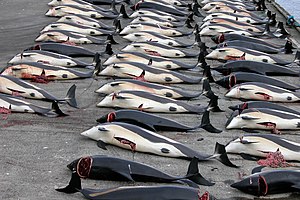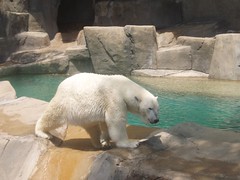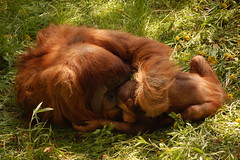Methane seen coming out of cracks in Arctic Sea ice...
More methane emissions lead to more warming, and more warming leads to more methane emissions.
Notorious company Asian Pulp and Paper (APP), linked to illegal logging and the clearance of Sumatran tiger habitat, today suffered another massive blow with Canadian investment giant Mackenzie Investments announcing that it has ceased in investing in APP operations...

The announcement comes on the back of another large international investor, Norway’s Skagen funds, selling its shares in Inda Kiat based on a “review of investment philosophy, ethical guidelines and our aim of providing our unit holders with the best possible risk adjusted return.” Indah Kiat’s share price fell a massive 25% last year alone.
Read more: http://draft.blogger.com/blogger.g?blogID=2358206553584963047#editor/target=post;postID=4496131052897553358
Ecospree
Iceberg the white Orca...
http://rt.com/news/white-killer-whale-russia-islands-751/
Ecospree

New Zealand's "Whio" or blue duck (hymenolaimus malacorhynchos) is a unique and threatened species of waterfowl endemic to that country. It is the only member of its genus and has no close relative anywhere on earth. It is a natural treasure of New Zealand.
It is believed that the blue ducks appeared at a very early stage in evolutionary history and the species' isolation in NZ has resulted in it acquiring a number of unique anatomical and behavioural features. The "Whio" really is a natural treasure of New Zealand.
Ecospree
As the Arctic warms due to global warming, the Arctic Ocean itself may be releasing vast amounts of methane, contributing to even more global warming, according to a study published today in the journal Nature Geoscience.

A new airborne study with NASA contributions measured surprising levels of the potent greenhouse gas methane coming from cracks in Arctic sea ice and areas of partial sea ice cover. This image was taken over the Arctic Ocean at a latitude of approximately 71 degrees North on April 15, 2010. (photo: NASA/JPL)
The researchers in the study led by Eric Kort of NASA’s Jet Propulsion Laboratory, Pasadena, Calif., recorded higher levels of methane above cracks in Arctic sea ice and areas of partial sea ice cover. The openings allowed Arctic seawater to interact with the air and methane in the surface waters to escape into the atmosphere. Higher methane readings were not found above solid ice.
“It’s possible that as large areas of sea ice melt and expose more ocean water, methane production may increase, leading to larger methane emissions,” Kort said.
“As Arctic sea ice cover continues to decline in a warming climate, this source of methane may well increase," he added.
Read more: http://www.commondreams.org/headline/2012/04/22-1#.T5xj9MJPrH0.facebook
Ecospree

A new airborne study with NASA contributions measured surprising levels of the potent greenhouse gas methane coming from cracks in Arctic sea ice and areas of partial sea ice cover. This image was taken over the Arctic Ocean at a latitude of approximately 71 degrees North on April 15, 2010. (photo: NASA/JPL)
The researchers in the study led by Eric Kort of NASA’s Jet Propulsion Laboratory, Pasadena, Calif., recorded higher levels of methane above cracks in Arctic sea ice and areas of partial sea ice cover. The openings allowed Arctic seawater to interact with the air and methane in the surface waters to escape into the atmosphere. Higher methane readings were not found above solid ice.
“It’s possible that as large areas of sea ice melt and expose more ocean water, methane production may increase, leading to larger methane emissions,” Kort said.
“As Arctic sea ice cover continues to decline in a warming climate, this source of methane may well increase," he added.
Read more: http://www.commondreams.org/headline/2012/04/22-1#.T5xj9MJPrH0.facebook
Ecospree
Sunday, May 6, 2012
Invester backlash results in APP contract cancellation...
Notorious company Asian Pulp and Paper (APP), linked to illegal logging and the clearance of Sumatran tiger habitat, today suffered another massive blow with Canadian investment giant Mackenzie Investments announcing that it has ceased in investing in APP operations...

The notorious company Asia Pulp and Paper (APP), linked to illegal logging and the clearance of Sumatran tiger habitat, today suffered another massive blow with Canadian investment giant Mackenzie Investments announcing that it has ceased investing in APP operations.
Greenpeace recently exposed APP’s main mill in Indonesia for using illegal timber to fuel its operations. Not only did Greenpeace investigations find that the Indah Kiat mill is systematically violating Indonesia’s laws protecting the internationally protected tree species ramin, it also found that the mill is supplied with rainforest timber from areas mapped as habitat of critically endangered species like the Sumatran tiger, whose numbers are down to an estimated 400 in the wild.
In a brief statement posted online, Mackenzie stated:
PT Indah Kiat Pulp & Paper Corp. TBK is no longer held by Mackenzie. Based on a full review of the holding and taking all aspects of the investment into consideration, the portfolio manager determined that the sale of Indah Kiat was in the best interest of the Funds.
As an Imagine Canada Caring Company, Mackenzie Investments embraces corporate citizenship and is committed to following ethical and environmentally responsible business practices. Greenpeace strongly welcomes Mackenzie’s move.The announcement comes on the back of another large international investor, Norway’s Skagen funds, selling its shares in Inda Kiat based on a “review of investment philosophy, ethical guidelines and our aim of providing our unit holders with the best possible risk adjusted return.” Indah Kiat’s share price fell a massive 25% last year alone.
Read more: http://draft.blogger.com/blogger.g?blogID=2358206553584963047#editor/target=post;postID=4496131052897553358
Ecospree
Peru: Dolphins in danger...
| Whaling in the Faroe Islands. These are Atlantic White-sided Dolphins, on a concrete-floored dock at a small port called Hvalba, which is in the Faeroe Islands, located between the UK and Iceland. They've been caught for food, as has been done for at least a thousand years. Birds surround them, just not in the picture. (Photo credit: Wikipedia) |
Peru: Dolphins in Danger:

Director: Uli Pfoertner | Producer: Gilde & Medienkontor
Genre: Documentary | Produced In: 2008 | Story Teller's Country: Germany
Tags: Peru, Americas, Animal Rights, Ecology, Conflict
 Synopsis: Unnoticed from the rest of the world, in Peru every year a minimum of 15,000 dolphins are killed by humans. This problem stems from poverty. The fishermen sell the meat as “Chancho Marino” (“sea-pig”) on the local markets. The film is on dolphins, and the humans who fight for their survival. These activists are, in a special way, a “community of destiny”: the fish in the world’s former richest fishing grounds - once for both, the basis of existence - is gone. The German biologist Stefan Austermuehle and his Peruvian wife Nina Pardo fight a tremendous battle against the seemingly permanent dolphin slaughter - in an unusual and sustainable way: undercover research with hidden cameras, operations against the dealers together with the police, but most of all the training of the fishermen to become tourist guides for dolphin watching. Through these efforts, they can change the lives of the dolphins and of themselves. By bringing the fishermen new sources of income, the “partnership” between man and animal will also secure the dolphins survival - along the cost as well as in the rainforest, where the Peruvian pink river dolphins also seem to be highly endangered....
Synopsis: Unnoticed from the rest of the world, in Peru every year a minimum of 15,000 dolphins are killed by humans. This problem stems from poverty. The fishermen sell the meat as “Chancho Marino” (“sea-pig”) on the local markets. The film is on dolphins, and the humans who fight for their survival. These activists are, in a special way, a “community of destiny”: the fish in the world’s former richest fishing grounds - once for both, the basis of existence - is gone. The German biologist Stefan Austermuehle and his Peruvian wife Nina Pardo fight a tremendous battle against the seemingly permanent dolphin slaughter - in an unusual and sustainable way: undercover research with hidden cameras, operations against the dealers together with the police, but most of all the training of the fishermen to become tourist guides for dolphin watching. Through these efforts, they can change the lives of the dolphins and of themselves. By bringing the fishermen new sources of income, the “partnership” between man and animal will also secure the dolphins survival - along the cost as well as in the rainforest, where the Peruvian pink river dolphins also seem to be highly endangered....
http://www.cultureunplugged.com/play/6672 View here:
Wednesday, April 25, 2012
Russian researchers have spotted an extremely rare white albino orca off the coast of Kamchatka for the first time in history...
Iceberg the white Orca...
A Russian research ship has spotted an extremely rare white adult orca, or killer whale, off the coast of Kamchatka for the first time in history. The reason for the whale's unusual pigmentation is as yet unexplained.
The scientists identified the whale by his pure white fin, swimming together with his pod, or family, all of which have the standard black and white coloration.
He has been given the nickname Iceberg, and appears to be behaving normally.
"Iceberg seems to be fully socialized; we know that these fish-eating orcas stay with their mothers for life, and as far as we can see he's right behind his mother with presumably his brothers next to him," said Dr. Erich Hoyt, who co-leads the scientific group that spotted the mammal.
Read more:
The scientists identified the whale by his pure white fin, swimming together with his pod, or family, all of which have the standard black and white coloration.
He has been given the nickname Iceberg, and appears to be behaving normally.
"Iceberg seems to be fully socialized; we know that these fish-eating orcas stay with their mothers for life, and as far as we can see he's right behind his mother with presumably his brothers next to him," said Dr. Erich Hoyt, who co-leads the scientific group that spotted the mammal.
Read more:
http://rt.com/news/white-killer-whale-russia-islands-751/
Ecospree
Thursday, April 19, 2012
Today: Live Broadcast on Polar bears
| Polar Bear (Photo credit: Kevin.Ward) |
| Polar Bears (Photo credit: bugmonkey) |
|
Friday, April 6, 2012
Orangutans are endangered by the destruction of lowland forests making way for palm oil plantations...
| Pongo pygmaeus English: A Bornean orangutan at Fort Worth Zoo, Texas, USA. (Photo credit: Wikipedia) |
| Orangutan (Photo credit: mizmak) |
| Orangutan (Photo credit: GreenWhiteOrange) |
The lowland forest habitats of Asia's only great ape are quickly disappearing. The are being cut down for timber or burned to make way for oil palm plantations and other agricultural developments.

Key facts
Species
Sumatran orangutan (Pongo abelii), Bornean orangutan (Pongo pygmaeus)Location
Sumatra (Indonesia), Borneo (Malaysia and Indonesia)Status
Endangered to Critically Endangered
Victims of logging and fire
Orangutans share a preference with humans for fertile alluvial plains and lowland valleys – a habitat once rich in tropical forests but now being replaced with logging and agricultural concessions.
Each of the two orangutan species is found only on the island from which it derives its name: Sumatra or Borneo. With numbers having fallen drastically over the past century and human pressures increasing, orangutans may be lost from the wild forever within a few decades.
Palm Oil is a threat to the Orangutang's future. Legal rhetoric is a deliberate obstacle to any government policy. Public boycotts of company products using palm oil can be effective. It was successful in New Zealand a couple of years ago.
Friday, March 23, 2012
The New Zealand Whio, or Blue Duck, is a unique and threatened species and treasure of New Zealand...
| Whio (Blue Duck, Hymenolaimus malacorhynchos) at Staglands in Akatarawa, New Zealand (Photo credit: Wikipedia) |
New Zealand's "Whio" or blue duck (hymenolaimus malacorhynchos) is a unique and threatened species of waterfowl endemic to that country. It is the only member of its genus and has no close relative anywhere on earth. It is a natural treasure of New Zealand.
It is believed that the blue ducks appeared at a very early stage in evolutionary history and the species' isolation in NZ has resulted in it acquiring a number of unique anatomical and behavioural features. The "Whio" really is a natural treasure of New Zealand.
Ecospree




























0 Comments:
Post a Comment
Subscribe to Post Comments [Atom]
<< Home